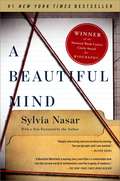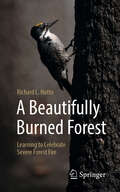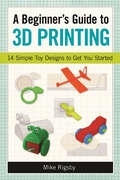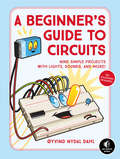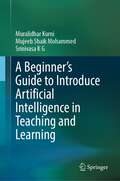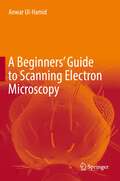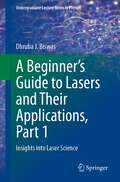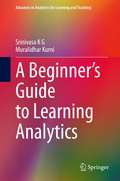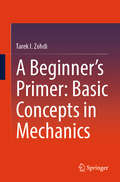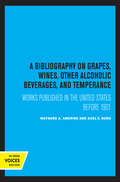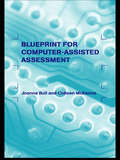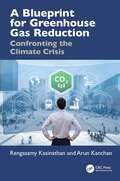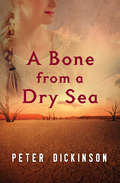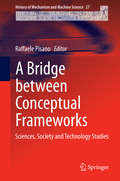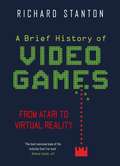- Table View
- List View
A Beautiful Mind (Shooting Script Ser.)
by Sylvia Nasar**Also an Academy Award–winning film starring Russell Crowe and Jennifer Connelly—directed by Ron Howard** The powerful, dramatic biography of math genius John Nash, who overcame serious mental illness and schizophrenia to win the Nobel Prize.“How could you, a mathematician, believe that extraterrestrials were sending you messages?” the visitor from Harvard asked the West Virginian with the movie-star looks and Olympian manner. “Because the ideas I had about supernatural beings came to me the same way my mathematical ideas did,” came the answer. “So I took them seriously.” Thus begins the true story of John Nash, the mathematical genius who was a legend by age thirty when he slipped into madness, and who—thanks to the selflessness of a beautiful woman and the loyalty of the mathematics community—emerged after decades of ghostlike existence to win a Nobel Prize for triggering the game theory revolution. The inspiration for an Academy Award–winning movie, Sylvia Nasar’s now-classic biography is a drama about the mystery of the human mind, triumph over adversity, and the healing power of love.
A Beautifully Burned Forest: Learning to Celebrate Severe Forest Fire
by Richard L. HuttoIn this book, avian ecologist and former PBS Birdwatch host Richard Hutto challenges conventional wisdom by revealing the hidden beauty and ecological importance of severely burned forests. Drawing on extensive field research and compelling storytelling, Hutto uncovers one of nature&’s best-kept secrets: numerous species—including the black-backed woodpecker and the morel mushroom—thrive in conditions created only by intense wildfires. These and many other fire-dependent organisms have evolved to flourish in charred landscapes, a fact often overlooked by birdwatchers, land managers, and even fire researchers. Blending science, fieldwork, and reflections from a lifelong career, this book has the potential to transform how we perceive forest fires. It offers a fresh perspective on fire&’s role in maintaining biodiversity and invites readers to consider how revised land management practices could benefit both industry and the environment. Written in an engaging and accessible style, this book is ideal for birdwatchers, nature enthusiasts, fire managers, and anyone curious about the true role of fire in our ecosystems.
A Beginner's Guide to 3D Modeling: A Guide to Autodesk Fusion 360
by Cameron CowardA Beginner&’s Guide to 3D Modeling is a project-based, straightforward introduction to computer-aided design (CAD). You&’ll learn how to use Autodesk Fusion 360, the world&’s most powerful free CAD software, to model gadgets, 3D print your designs, and create realistic images just like an engineering professional—with no experience required! Hands-on modeling projects and step-by-step instructions throughout the book introduce fundamental 3D modeling concepts. As you work through the projects, you&’ll master the basics of parametric modeling and learn how to create your own models, from simple shapes to multipart assemblies. Once you&’ve mastered the basics, you&’ll learn more advanced modeling concepts like sweeps, lofts, surfaces, and rendering, before pulling it all together to create a robotic arm. You&’ll learn how to:• Design a moving robotic arm, a door hinge, a teapot, and a 20-sided die• Create professional technical drawings for manufacturing and patent applications • Model springs and other complex curves to create realistic designs • Use basic Fusion 360 tools like Extrude, Revolve, and Hole• Master advanced tools like Coil and ThreadWhether you&’re a maker, hobbyist, or artist, A Beginner&’s Guide to 3D Modeling is certain to show you how to turn your ideas into professional models. Go ahead—dust off that 3D printer and feed it your amazing designs.
A Beginner's Guide to 3D Printing: 14 Simple Toy Designs to Get You Started
by Mike RigsbyA Beginner's Guide to 3D Printing is the perfect resource for those who would like to experiment with 3D design and manufacturing, but have little or no technical experience with the standard software. Author Mike Rigsby leads readers step-by-step through 15 simple toy projects, each illustrated with screen caps of Autodesk 123D Design, the most common free 3D software available. The projects are later described using Sketchup, another free popular software package. Beginning with basics projects that will take longer to print than design, readers are then given instruction on more advanced toys, including a baking-powder submarine, a train with expandable track, a multipiece airplane, a rubber band-powered car, and a noise-making push toy with froggy eyes. Once trained in the basics of computer-aided design, readers will be able to embark on even more elaborate projects of their own creation.
A Beginner's Guide to Circuits: Nine Simple Projects with Lights, Sounds, and More!
by Oyvind Nydal DahlA Beginner's Guide to Circuits is the perfect first step for anyone ready to jump into the world of electronics and circuit design. After finishing the book's nine graded projects, readers will understand core electronics concepts which they can use to make their own electrifying creations!First, you'll learn to read circuit diagrams and use a breadboard, which allows you to connect electrical components without using a hot soldering iron! Next, you'll build nine simple projects using just a handful of readily available components, like resistors, transistors, capacitors, and other parts. As you build, you'll learn what each component does, how it works, and how to combine components to achieve new and interesting effects.By the end of the book, you'll be able to build your own electronic creations. With easy-to-follow directions, anyone can become an inventor with the help of A Beginner's Guide to Circuits!Build These 9 Simple Circuits! * Steady-Hand Game: Test your nerves using a wire and a buzzer to create an Operation-style game! * Touch-Enabled Light: Turn on a light with your finger! * Cookie Jar Alarm: Catch cookie thieves red-handed with this contraption. * Night-Light: Automatically turn on a light when it gets dark. * Blinking LED: This classic circuit blinks an LED. * Railroad Crossing Light: Danger! Don't cross the tracks if this circuit's pair of lights is flashing. * Party Lights: Throw a party with these charming string lights. * Digital Piano: Play a tune with this simple synthesizer and learn how speakers work. * LED Marquee: Put on a light show and impress your friends with this flashy finale.<
A Beginner's Guide to Introduce Artificial Intelligence in Teaching and Learning
by Srinivasa K G Muralidhar Kurni Mujeeb Shaik MohammedThis book reimagines education in today’s Artificial Intelligence (AI) world and the Fourth Industrial Revolution. Artificial intelligence will drastically affect every industry and sector, and education is no exception. This book aims at how AI may impact the teaching and learning process in education. This book is designed to demystify AI for teachers and learners. This book will help improve education and support institutions in the phenomena of the emergence of AI in teaching and learning. This book presents a comprehensive study of how AI improves teaching and learning, from AI-based learning platforms to AI-assisted proctored examinations. This book provides educators, learners, and administrators on how AI makes sense in their everyday practice. Describing the application of AI in ten key aspects, this comprehensive volume prepares educational leaders, designers, researchers, and policymakers to effectively rethink the teaching and learning process and environments that students need to thrive. The readers of this book never fall behind the fast pace and promising innovations of today’s most advanced learning technology.
A Beginner's Guide to Medical Application Development with Deep Convolutional Neural Networks
by Nilanjan Dey Amartya Mukherjee Snehan BiswasThis book serves as a source of introductory material and reference for medical application development and related technologies by providing the detailed implementation of cutting-edge deep learning methodologies. It targets cloud-based advanced medical application developments using open-source Python-based deep learning libraries. It includes code snippets and sophisticated convolutional neural networks to tackle real-world problems in medical image analysis and beyond.Features: Provides programming guidance for creation of sophisticated and reliable neural networks for image processing. Incorporates the comparative study on GAN, stable diffusion, and its application on medical image data augmentation. Focuses on solving real-world medical imaging problems. Discusses advanced concepts of deep learning along with the latest technology such as GPT, stable diffusion, and ViT. Develops applicable knowledge of deep learning using Python programming, followed by code snippets and OOP concepts. This book is aimed at graduate students and researchers in medical data analytics, medical image analysis, signal processing, and deep learning.
A Beginners' Guide to Scanning Electron Microscopy
by Anwar Ul-HamidThis book was developed with the goal of providing an easily understood text for those users of the scanning electron microscope (SEM) who have little or no background in the area. The SEM is routinely used to study the surface structure and chemistry of a wide range of biological and synthetic materials at the micrometer to nanometer scale. Ease-of-use, typically facile sample preparation, and straightforward image interpretation, combined with high resolution, high depth of field, and the ability to undertake microchemical and crystallographic analysis, has made scanning electron microscopy one of the most powerful and versatile techniques for characterization today. Indeed, the SEM is a vital tool for the characterization of nanostructured materials and the development of nanotechnology. However, its wide use by professionals with diverse technical backgrounds—including life science, materials science, engineering, forensics, mineralogy, etc., and in various sectors of government, industry, and academia—emphasizes the need for an introductory text providing the basics of effective SEM imaging.A Beginners’ Guide to Scanning Electron Microscopy explains instrumentation, operation, image interpretation and sample preparation in a wide ranging yet succinct and practical text, treating the essential theory of specimen-beam interaction and image formation in a manner that can be effortlessly comprehended by the novice SEM user. This book provides a concise and accessible introduction to the essentials of SEMincludes a large number of illustrations specifically chosen to aid readers' understanding of key conceptshighlights recent advances in instrumentation, imaging and sample preparation techniquesoffers examples drawn from a variety of applications that appeal to professionals from diverse backgrounds.
A Beginner’s Guide to Internet of Things Security: Attacks, Applications, Authentication, and Fundamentals
by B. B. Gupta Aakanksha TewariA Beginner’s Guide to Internet of Things Security focuses on security issues and developments in the Internet of Things (IoT) environment. The wide-ranging applications of IoT, including home appliances, transportation, logistics, healthcare, and smart cities, necessitate security applications that can be applied to every domain with minimal cost. IoT contains three layers: application layer, middleware layer, and perception layer. The security problems of each layer are analyzed separately to identify solutions, along with the integration and scalability issues with the cross-layer architecture of IoT. The book discusses the state-of-the-art authentication-based security schemes, which can secure radio frequency identification (RFID) tags, along with some security models that are used to verify whether an authentication scheme is secure against any potential security risks. It also looks at existing authentication schemes and security models with their strengths and weaknesses. The book uses statistical and analytical data and explains its impact on the IoT field, as well as an extensive literature survey focusing on trust and privacy problems. The open challenges and future research direction discussed in this book will help to further academic researchers and industry professionals in the domain of security. Dr. Brij B. Gupta is an assistant professor in the Department of Computer Engineering, National Institute of Technology, Kurukshetra, India. Ms. Aakanksha Tewari is a PhD Scholar in the Department of Computer Engineering, National Institute of Technology, Kurukshetra, India.
A Beginner’s Guide to Lasers and Their Applications, Part 1: Insights into Laser Science (Undergraduate Lecture Notes in Physics)
by Dhruba J. BiswasThis two-volume book provides an enriching insight into the laser, covering different types of lasers, the basic science behind the technology, their role at the cutting-edge of current scientific research, and their wide-ranging applications. With just high school physics as a prerequisite and favoring qualitative yet scientifically sound explanations over high-level mathematics, this book is aimed at a broad spectrum of readers in physics, chemistry, engineering, medicine, and biology. Its engaging and lucid presentation is enhanced with plenty of illustrations, making the world of the laser accessible to undergraduate students in the sciences and any other inquisitive readers with high school physics under their belts. Furthermore, the text is often laced with anecdotes, picked from history, that are bound to pique the minds of the readers. It is ideal for self-study or as a complement to courses on optics and optoelectronics. This volume, Part 1 of 2, explains the fundamentals of optics, what a laser is, how it works, and what is unique about the light it emits, from fundamental quantum theory through population inversion and cavity to common laser types. It is followed by Part 2 which depicts the many advances in science enabled by the laser, including spectroscopy, nonlinear optics, optical cooling and trapping, and optical tweezers, among many others, and provides a glimpse into the ways that the laser affects our lives via its uses in medicine, manufacturing, the nuclear industry, energy, defence, communication, ranging, pollution monitoring, art conservation, fashion, beauty, and entertainment.
A Beginner’s Guide to Learning Analytics (Advances in Analytics for Learning and Teaching)
by Srinivasa K G Muralidhar KurniThis book A Beginner’s Guide to Learning Analytics is designed to meet modern educational trends’ needs. It is addressed to readers who have no prior knowledge of learning analytics and functions as an introductory text to learning analytics for those who want to do more with evaluation/assessment in their organizations. The book is useful to all who need to evaluate their learning and teaching strategies. It aims to bring greater efficiency and deeper engagement to individual students, learning communities, and educators.Covered here are the key concepts linked to learning analytics for researchers and practitioners interested in learning analytics. This book helps those who want to apply analytics to learning and development programs and helps educational institutions to identify learners who require support and provide a more personalized learning experience. Like chapters show diverse uses of learning analytics to enhance student and faculty performance. It presents a coherent framework for the effective translation of learning analytics research for educational practice to its practical application in different educational domains. This book provides educators and researchers with the tools and frameworks to effectively make sense of and use data and analytics in their everyday practice. This book will be a valuable addition to researchers’ bookshelves.
A Beginner’s Guide to Multilevel Image Thresholding (Intelligent Signal Processing and Data Analysis)
by Nilanjan Dey Venkatesan Rajinikanth Nadaradjane Sri Madhava RajaA Beginner’s Guide to Image Multi-Level Thresholding emphasizes various image thresholding methods that are necessary for image pre-processing and initial level enhancement. Explains basic concepts and the implementation of Image Multi-Level Thresholding (grayscale and RGB images) Presents a detailed evaluation in real-time application, including the need for heuristic algorithm, the choice of objective and threshold function, and the evaluation of the outcome Describes how the image thresholding acts as a pre-processing technique and how the region of interest in a medical image is enhanced with thresholding Illustrates integration of the thresholding technique with bio-inspired algorithms Includes current findings and future directions of image multi-level thresholding and its practical implementation Emphasizes the need for multi-level thresholding with suitable examples The book is aimed at graduate students and researchers in image processing, electronics engineering, computer sciences and engineering.
A Beginner’s Primer: Basic Concepts in Mechanics
by Tarek I. ZohdiAs we enter an exciting new era in industrial design, simulation, and manufacturing, a clear understanding of mechanics of solids is needed now more than ever. This primer is a condensed synopsis of basic undergraduate mechanics and is designed to supplement classical textbooks in this area. The focus is on the essentials of mechanics, specifically: • The concept of stress. • Stress-strain relationships. • Failure theory. • Axial loading of a rod. • Transverse (bending) loading of a beam. • Industrial application: modeling of 3D printing. • Transverse shear stresses. • Torsional loading of a rod. • Pressure vessels. • Buckling of columns. • The basics of finite element methods. • A unifying concept: continuum mechanics.
A Bibliography on Grapes, Wines, Other Alcoholic Beverages, and Temperance: Works Published in the United States Before 1901 (UC Publications in Catalogs and Bibliographies #12)
by M. A. Amerine Axel E. BorgThis title is part of UC Press's Voices Revived program, which commemorates University of California Press’s mission to seek out and cultivate the brightest minds and give them voice, reach, and impact. Drawing on a backlist dating to 1893, Voices Revived makes high-quality, peer-reviewed scholarship accessible once again using print-on-demand technology. This title was originally published in 1996.
A Billion Little Pieces: RFID and Infrastructures of Identification (Infrastructures)
by Jordan FrithHow RFID, a ubiquitous but often invisible mobile technology, identifies tens of billions of objects as they move through the world.RFID (Radio Frequency Identification) is ubiquitous but often invisible, a mobile technology used by more people more often than any flashy smartphone app. RFID systems use radio waves to communicate identifying information, transmitting data from a tag that carries data to a reader that accesses the data. RFID tags can be found in credit cards, passports, key fobs, car windshields, subway passes, consumer electronics, tunnel walls, and even human and animal bodies—identifying tens of billions of objects as they move through the world. In this book, Jordan Frith looks at RFID technology and its social impact, bringing into focus a technology that was designed not to be noticed.RFID, with its ability to collect unique information about almost any material object, has been hyped as the most important identification technology since the bar code, the linchpin of the Internet of Things—and also seen (by some evangelical Christians) as a harbinger of the end times. Frith views RFID as an infrastructure of identification that simultaneously functions as an infrastructure of communication. He uses RFID to examine such larger issues as big data, privacy, and surveillance, giving specificity to debates about societal trends. Frith describes how RFID can monitor hand washing in hospitals, change supply chain logistics, communicate wine vintages, and identify rescued pets. He offers an accessible explanation of the technology, looks at privacy concerns, and pushes back against alarmist accounts that exaggerate RFID's capabilities. The increasingly granular practices of identification enabled by RFID and other identification technologies, Frith argues, have become essential to the working of contemporary networks, reshaping the ways we use information.
A Bird Atlas of Kenya
by Adrian LewisKenya, a country only the size of Texas, has one of the richest avifaunas in Africa. This atlas is an explanatory overview of Kenya's 1065 species, essential both to the birdwatcher as a means of finding birds and interpreting the significance of field observations, and to the ornithologist as a standard reference work.
A Black Hole is Not a Hole: Updated Edition
by Carolyn Cinami DeCristofanoA black hole isn't really a hole . . . is it? Get ready to S-T-R-E-T-C-H your mind with this beloved and best-selling science book. Updated with an all-new chapter about the first black-hole image ever!What are black holes, what causes them, and how the heck did scientists discover them? Acclaimed STEM writer Carolyn DeCristofano's playful text shares how astronomers find black holes, introduces our nearest black-hole neighbors, and provides an excellent introduction to an extremely complex scientific topic. Gorgeous space paintings supplement real telescopic images, and funny doodles and speech bubbles keep the content light and fun.
A Blueprint for Computer-Assisted Assessment
by Joanna Bull Colleen McKennaThe rapid development and integration of computer-assisted assessment (CAA) in mainstream post-compulsory educational institutions today make this an exciting and invaluable reference text. It provides a practical, research-based guide on a subject that is becoming increasingly important as educational assessment changes and grows.The book addresses theory and practice, offering a comprehensive evaluation of many key aspects of CAA such as: * question and test design, scoring and analysis, and feedback and integration with other assessment methods* the role of CAA in feedback processes* wider use of technology to support and enhance assessment* technical, operational and support issues.The authors present a lucid,balanced analysis of the strengths and weaknesses of CAA. This text will appeal to all those involved in higher or further education who wish to model their CAA systems on the best practice available.
A Blueprint for Greenhouse Gas Reduction: Confronting the Climate Crisis
by Rengasamy Kasinathan Arun KanchanThis comprehensive book details greenhouse gas (GHG) emissions across a range of sources, sectors, and countries, with particular emphasis on the United States and other developed nations. It presents an in-depth analysis, covering the roles of industries, policymakers, and regulatory frameworks in contributing to and mitigating GHG emissions. The authors discuss emission measurement and monitoring methodologies, supported by real-life case studies illustrating how corporations, policymakers, and industry leaders can implement responsible decarbonization strategies. Additionally, it covers the critical verification aspect of enforcing climate policies and regulations.Features Provides a detailed sector-wise breakdown of GHG emissions across energy, transportation, industry, and agriculture. Explains the scientific basis of emissions and their regulatory frameworks governing them under global agreements such as the Paris Agreement and U.S. EPA policies. Presents recommendations for energy-efficient strategies and key actions that industries and policymakers can adopt to reduce GHG emissions. Highlights AI, big data, and IoT as tools for carbon monitoring and emission tracking. Offers guidance for professionals and scholars on estimating emissions and implementing reduction methods at both organizational and policy levels. This book is essential for environmental and energy professionals, policymakers, corporate sustainability officers, researchers, and industry leaders engaged in emissions reduction, regulatory compliance, and climate policy. It is also a valuable resource for EHS personnel, facility administrators, students, and faculty studying and teaching the environmental impacts of GHG emissions.
A Bone from a Dry Sea
by Peter DickinsonOn a prehistoric shore, a young girl fights to help her tribe survive She is at home in the ocean, as comfortable in the water as she is on dry land. The child’s people have made their homes by the bay for as long as anyone can remember, diving for mussels and any other food the ocean will serve to them. They have no language; they have no names. Although they know love and jealousy and pride, they are not quite human—not yet. This child of the sea will show them the way. Two million years later, Vinny is visiting her father at an archaeological site in Africa when they discover the remains of that forgotten tribe of cliff dwellers. Across the ocean of time, these two young women will find a connection, an inexplicable bond that builds slowly but arrives with all the power of a tidal wave. This ebook features an illustrated personal history of Peter Dickinson including rare images from the author’s collection.
A Brain-Inspired Approach to Natural Language Processing (Studies in Computational Intelligence #1225)
by Herwig Unger Thasayu SoisoonthornThis book brings together key ideas from neuroscience and artificial intelligence to show how they can work together. It helps readers understand how studying the brain can lead to more adaptable and efficient AI systems. Instead of treating the two fields as separate, it highlights how brain-inspired models can help overcome current challenges in AI, improve existing techniques, and spark new and creative solutions.The journey begins with the biological foundations of intelligence, focusing on the brain&’s structure, evolution, and functions, particularly the neocortex, which plays a central role in learning and prediction. Building on this foundation, the book surveys both traditional and modern AI methods in an accessible way and offers a critical analysis of their strengths and shortcomings. The discussion then moves from theory to practice, showing how brain-inspired ideas can be applied to real-world Natural Language Processing (NLP) tasks such as spelling correction and Thai word segmentation, where conventional models often struggle with nuance and complexity. In its final sections, the book reflects on the broader significance of integrating neuroscience and AI, encouraging continued exploration and innovation at the intersection of these disciplines. Key benefits of this book include: - Exploring biologically plausible models of intelligence to open new pathways- Gaining foundational insights into how neuroscience can inform AI design- Presenting practical examples to enhance NLP tasks in complex languages- Offering a testbed for experimentation with brain-inspired computational models- Serving as a valuable resource for advanced students, researchers, and professionals seeking to deepen their understanding of nature-inspired intelligent systems While refining existing AI models may lead to meaningful progress, it remains uncertain whether such approaches alone can achieve a deeper form of intelligence. By contrast, drawing inspiration from the structure and function of the human brain may offer a promising direction toward creating systems that are more flexible, adaptive, and capable of exhibiting human-like behavior.
A Bridge between Conceptual Frameworks: Sciences, Society and Technology Studies (History of Mechanism and Machine Science #27)
by Raffaele PisanoThis book analyzes scientific problems within the history of physics, engineering, chemistry, astronomy and medicine, correlated with technological applications in the social context. When and how is tension between disciplines explicitly practised? What is the conceptual bridge between science researches and the organization of technological researches in the development of industrial applications? The authors explain various ways in which the sciences allowed advanced modelling on the one hand, and the development of new technological ideas on the other hand. An emphasis on the role played by mechanisms, production methods and instruments bestows a benefit on historical and scientific discourse: theories, institutions, universities, schools for engineers, social implications as well. Scholars from different traditions discuss the emergency style of thinking in methodology and, in theoretical perspective, aim to gather and re-evaluate the current thinking on this subject. It brings together contributions from leading experts in the field, and gives much-needed insight into the subject from a historical point of view. The volume composition makes for absorbing reading for historians, philosophers and scientists.
A Brief History Of Video Games
by Rich StantonA Brief History of Video Games describes and explains the remarkable evolution of interactive entertainment, from the demonstration of Nimrod in 1951 to full-body virtual reality in 2014. Video games are a technology-led medium and this book examines everything from the first wood-panelled Pong machines in California right up to the engineering masterpieces that now sit in countless homes, with brief stopovers for dead-ends like Philips CDi and early VR. Most importantly, it?s all about the games ? how these experiences have evolved from simple call-and-response mechanics into sophisticated, captivating worlds, responsive in just about every way to players.
A Brief History Of Video Games: From Atari to Virtual Reality (Brief Histories)
by Rich Stanton'Stanton writes with terrific verve and precision . . . his understanding of the seductive pleasures of gaming takes us right to its heart.'Maria Bustillos, Times Literary Supplement'The best overview book of the industry that I've read.'Andrew Liptak, io9From the first wood-panelled Pong machines in California to the masterpieces of engineering that now sit in countless homes all over the world, A Brief History of Video Games reveals the vibrant history and culture of interactive entertainment. Above all, this is a book about the games - how the experience of playing has developed from simple, repetitive beginnings into a cornucopia of genres and styles, at once utterly immersive and socially engaging. With full-colour illustrations throughout, it shows how technological advances have transformed the first dots and dashes of bored engineers into sophisticated, responsive worlds that are endlessly captivating. As thrilling and surprising as the games it describes, this is an indispensable read for anyone serious about the business of having fun.
A Brief History of Artificial Intelligence: What It Is, Where We Are, and Where We Are Going
by Michael WooldridgeFrom Oxford's leading AI researcher comes a fun and accessible tour through the history and future of one of the most cutting edge and misunderstood field in science: Artificial IntelligenceThe somewhat ill-defined long-term aim of AI is to build machines that are conscious, self-aware, and sentient; machines capable of the kind of intelligent autonomous action that currently only people are capable of. As an AI researcher with 25 years of experience, professor Mike Wooldridge has learned to be obsessively cautious about such claims, while still promoting an intense optimism about the future of the field. There have been genuine scientific breakthroughs that have made AI systems possible in the past decade that the founders of the field would have hailed as miraculous. Driverless cars and automated translation tools are just two examples of AI technologies that have become a practical, everyday reality in the past few years, and which will have a huge impact on our world.While the dream of conscious machines remains, Professor Wooldridge believes, a distant prospect, the floodgates for AI have opened. Wooldridge's A Brief History of Artificial Intelligence is an exciting romp through the history of this groundbreaking field--a one-stop-shop for AI's past, present, and world-changing future.
